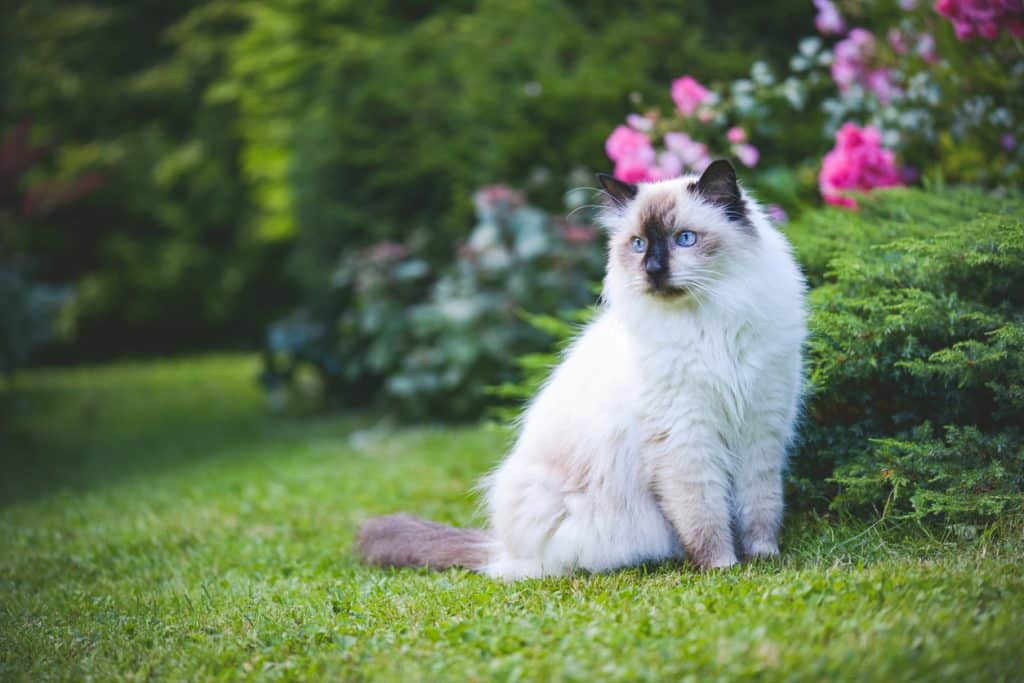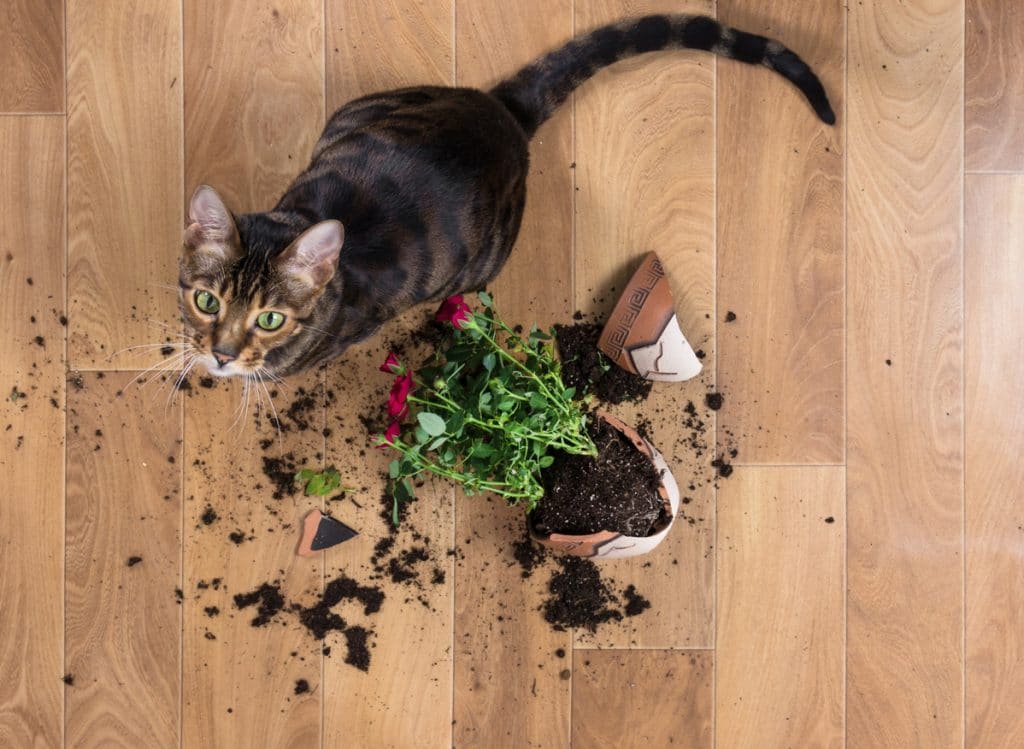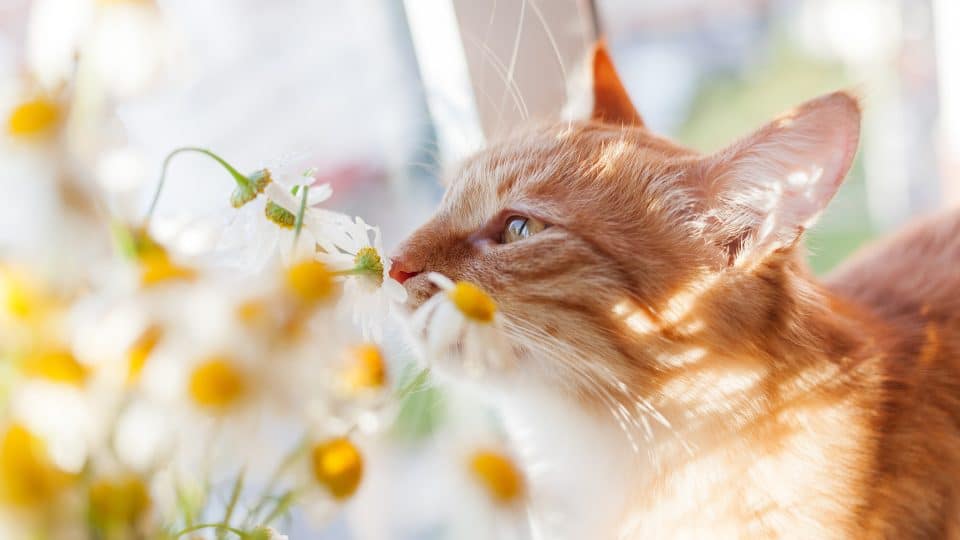Adding plants to your home is a fresh and lively way to decorate. But many plants are toxic or even deadly to cats. Toxicity varies widely from plant to plant and can sometimes include the entire plant or only certain parts. Both common indoor and outdoor plants and herbs can be hazardous to your cat’s health.
We spoke with Dr Veronica Villanueva, medical director of Veterinary Emergency Group Anaheim Hills, to learn more about toxic plants, signs to watch out for if you think your cat ate a poisonous plant, and tips to keep hazardous greenery out of your cat’s reach.
Houseplants
You may be surprised to learn that many houseplants are toxic to cats. Below are some of the most common ones to be aware of.
- Sago Palm: All parts of this houseplant are severely toxic and can even be deadly for cats. It can cause vomiting, diarrhoea or bloody stools, lethargy, decreased appetite, and seizures.
- Aloe Vera: Though calming for humans, aloe vera causes mild to moderate toxicity in cats. Specifically, the white latex sap found in the aloe plant’s leaves is poisonous for cats to ingest. Consuming it may cause depression, diarrhoea, vomiting, lethargy, changes in urine colour, and tremors.
- Pothos: All parts of these flowering plants are toxic to cats. They can cause mild to moderate symptoms, including vomiting, diarrhoea, oral irritation, and difficulty swallowing.
- Snake Plants (Dracaena Trifasciata): These plants are toxic to cats because they contain saponins, which cause gastrointestinal upset. Ingestion can cause cats abdominal pain or mouth swelling, along with vomiting, drooling, lethargy, and lack of appetite.
- English Ivy: Common as both an outdoor plant and a houseplant, all parts of English ivy are poisonous to cats. It can cause mild to moderate symptoms, like drooling, vomiting, diarrhoea, and abdominal pain.
- Jade Plant: All parts of these plants are considered mildly toxic to felines and can cause vomiting, lethargy, weakness, and depression.
- Dieffenbachia: A common houseplant, these can also be found in the wild and gardens. Ingesting any part of this plant can cause mild to moderate symptoms, including drooling, oral pain, pawing at the mouth, decreased appetite, or vomiting.
- Philodendron: These flowering plants include hundreds of climbing and non-climbing vines that are toxic to cats because of their calcium oxalate crystals. Ingesting them can cause mouth pain and swelling, excessive drooling, vomiting, loss of appetite, and difficulty swallowing or breathing.
- Asparagus Fern: The leaves and berries of this plant cause mild to moderate toxicity in cats. If ingested, your cat may display symptoms like vomiting, diarrhoea, abdominal pain, or skin irritation.
- Schefflera (Umbrella Plant): All parts of these plants are toxic to cats and cause symptoms, including drooling, oral pain that could lead to your cat pawing at their mouth, decreased appetite, and vomiting.
- Fiddle Leaf Fig: Cats can be poisoned by all parts of this houseplant, which is a part of the Philodendron family. It can cause issues like drooling, oral pain, decreased appetite, or vomiting.
- Monstera: All parts of this plant are mildly toxic to cats due to its sap containing calcium oxalate crystals. It can cause throat, eye, and mouth irritation and digestive issues.
- Lilies: “All parts of the lily are extremely toxic to cats, and even a small amount can cause kidney failure,” warns Dr Villanueva. Even the pollen from lilies can be hazardous to your cat’s health. Lilies can cause a variety of symptoms, including vomiting, diarrhoea, drooling, lethargy, decreased appetite, disorientation, dehydration, tremors, or seizures.
- Kalanchoe: While the entire plant is toxic to cats, its flowers are the most dangerous. It can cause mild to moderate symptoms, including vomiting, diarrhoea, and drooling.
- Taro (Elephant Ears): This is another house and wild plant that contains calcium oxalate crystals that are toxic to cats. Ingesting it can cause oral pain, swelling, difficulty swallowing, and stomach upset.
Flowers & Herbs
Both indoor and outdoor flowers and herbs can be poisonous to felines. Here are 12 of the most common.
- Lilies: All lilies (whether indoor or outdoor varieties) are extremely toxic and can even be deadly plants to cats. This includes Easter, tiger, and Asiatic lilies.
- Poinsettias: Though a holiday staple, these festive flowers contain a milky white sap that’s toxic to cats. “They can cause stomach upset and irritated skin and eyes,” said Dr Villanueva. In addition, they can also cause drooling and excessive lip licking.
- Tulips & Hyacinths: While all parts of these plants are toxic to cats, ingesting the bulb is the most dangerous. Cats may experience symptoms such as drooling, nausea, vomiting, or increased heart or respiratory rate.
- Amaryllis: All parts of these striking garden and houseplants cause mild to moderate toxicity in cats. Common symptoms include hypotension, vomiting, abdominal discomfort, and respiratory depression.
- Chrysanthemum: Also known as the mum, all parts of these plants are toxic to cats. They can cause issues like vomiting, decreased appetite, and diarrhoea.
- Begonias: The underground parts of these plants are the most toxic to cats because they contain soluble calcium oxalates. They can cause reactions, including mouth irritation or sores, excessive salivation, dehydration, and even kidney failure.
- Butterfly Iris (Iris Spuria): All parts of this flower are toxic to cats, but their rhizomes (underground stems) and bulbs have the highest concentration of toxins. Ingesting them can cause drooling, lethargy, skin irritation, vomiting, diarrhoea, and ulcers.
- Chives: Though a tasty addition to human dishes, all parts of the chive plant are poisonous to cats (along with their plant family members, onions and garlic). If ingested, a cat may experience vomiting, difficulty breathing, lethargy, lack of appetite, or diarrhoea.
- Daisies: All parts of this flower are harmful to cats. If cats eat one, they may experience vomiting, diarrhoea, skin irritation, excessive drooling, or difficulty walking.
- Dahlias: Ingesting any part of this flower can poison your cat. They may show symptoms including stomach upset, skin irritation or itching, excessive drinking or urination, irregular heartbeat, and overall weakness.
- Desert rose: All parts of this plant are harmful to cats because of their cardiac glycosides. They can cause weakness, drooling, gastrointestinal upset, abnormal heart rates, and even death.
- Oregano: All parts of this herb are toxic to cats due to the oils they contain. Ingesting it can cause oral irritation, shallow breathing, nausea, vomiting, and diarrhoea.
Garden & Outdoor Plants

iStock/elenaleonova
Garden and wild plants can also pose a threat to your cat’s health. Outdoor kitties are especially at risk from the following.
- Azaleas: All parts of these bright garden flowers cause severe toxicity and can be deadly for cats. Ingesting them can cause depression, blindness, seizures, hypotension, abdominal pain, an abnormal heartbeat, drooling, or stomach upset.
- Oleanders: These garden plants are highly toxic to cats. They can cause heart failure and even death.
- Daffodils: Though a sign of spring, these common garden plants are mild to moderately toxic to cats. They can cause symptoms such as drooling, nausea, vomiting, abdominal pain, abnormal breathing, and increased heart rate.
- Nightshades: These wild plants cause mild to moderate issues for cats if ingested, including anaemia, diarrhoea, vomiting, seizures, or lethargy.
- Wisteria: Wisteria seeds and pods are the most toxic to cats if ingested. They can cause dehydration, gastrointestinal upset, tremors, lethargy, and confusion.
- Yew: The main toxin in these plants is called taxine, which can have rapid and severe effects on your cat’s cardiac system. Symptoms of yew poisoning include seizures, difficulty walking, abnormal heart rate, and tremors.
- Caladium: All parts of this plant are toxic to felines because of its calcium oxalate crystals. It can cause drooling, decreased appetite, vomiting, or oral pain.
- Bird of Paradise: Found mainly in tropical climates, the seeds and leaves of this exotic plant are poisonous to cats. Symptoms of poisoning include gastrointestinal issues, drowsiness, drooling, and skin irritation.
- Branching Ivy: This garden plant causes mild to moderate toxicity in cats. It can cause abdominal pain or upset, drooling, excessive thirst, burning in the throat or mouth, and loss of coordination.
- Ficus: All parts of this plant are poisonous to cats if ingested. It can cause symptoms including decreased appetite, drooling, skin irritation, vomiting, and diarrhoea.
Signs Your Cat Has Been Poisoned & What To Do

iStock/Nataliia Pyzhova
According to Dr Villanueva, signs of poisoning can vary depending on what plant your cat ingested. Some common signs to look for include:
- Gastrointestinal upset (vomiting and/or diarrhoea)
- Lethargy and/or weakness
- Drooling or excessive salivation
- Panting and difficulty breathing
- Shaking, tremors, or seizures
- Loss of appetite
- Dilated or constricted pupils
- Change in behaviour (confusion, irritability)
If your cat has ingested a plant and is exhibiting strange behaviours or symptoms, contact your vet immediately, or call the UK’s paid-for 24-hour Animal Poison Line on 01202 509000.
Prevention Tips and Cat-Proofing Ideas
Cats are naturally curious creatures. If you plan on bringing a new plant into your home, Dr Villanueva recommends following these cat-proofing tips to keep your feline safe.
- Place plants out of reach. Use high shelves or hanging plant baskets that your cat can’t reach.
- Use plant barriers. “You can use mesh or other physical barriers or assign a room to your plants that cats do not go in,” says Dr Villanueva.
- Do your research. Before bringing a plant into your home, confirm it’s not toxic to your feline friends. If it is, use one of the two methods above to keep it out of your cat’s reach. Better yet, look for cat-safe plants like cat grass and catnip.



